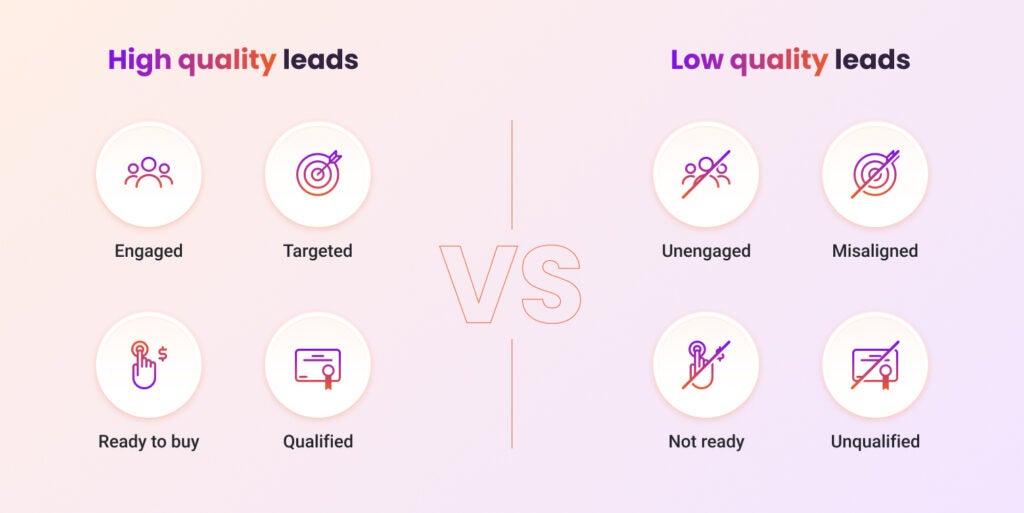Demand generation teams are all trying to do one thing: Drive more pipeline with their lead generation programs.
But they often get stuck in a quantity mindset instead of a quality mindset.
In other words, they end up measuring the success of their campaigns by the number of leads generated, instead of focusing on more important metrics—like whether or not those leads showed high engagement or turned into booked meetings with their sales team.
Sound familiar?
In a world where B2B marketers are constantly being asked to “do more with less,” it’s more important than ever to ensure your lead gen programs are top-notch. Whether you’re running your own campaigns in-house or partnering with lead generation providers, this means driving high-quality leads that will actually convert into pipeline and revenue for your business.
This is often easier said than done. In fact, 54% of marketers say one of the biggest challenges they face is improving lead quality. In this blog post, we’ll break down what you need to consider when it comes to generating high-quality leads, including what to measure to ensure you’re getting the most out of your campaigns and your marketing spend.
Let’s dive in.
What is lead quality?
Lead quality refers to the likelihood that a potential customer, or lead, will convert into a paying customer. For demand gen marketers, this is a critical metric that helps determine the effectiveness of your marketing efforts and the overall success of your campaigns.

Long story short, high-quality leads are those that:
- closely match your ideal customer profile (ICP)
- show genuine interest in the product or service you offer, and
- have a higher chance of moving through the sales funnel to become a customer
Why is measuring lead quality so important?
Focusing on lead quality is essential for optimizing your marketing efforts and ensuring a strong return on investment (ROI). When you focus on the quality of leads your campaigns are generating, you’re more likely to target prospects that will turn into customers. This not only improves conversion rates but also reduces overall cost per acquisition (CPA).
While it may be tempting to focus on generating as many leads as possible, it’s much more effective to provide your sales team with high-quality leads that will result in shorter sales cycles. This will not only boost sales performance but also foster more trust and create better alignment between marketing and sales. In this scenario, everybody wins!
How to measure lead quality: 3 things to consider when working with a lead generation provider
If you’re outsourcing your lead gen efforts to a third-party provider, getting a firm handle on what makes a high-quality lead is even more important. You’re going to want to make sure they’re delivering the goods. But how?

Some lead gen providers get a bad rap for focusing on delivering a high quantity of leads rather than quality leads. But not all lead generation providers operate this way. In fact, many lead generation partners (the good ones, anyway!) have evolved from simply handing over a large lead list to partnering with their customers to optimize their campaigns and maximize ROI by creating parameters around intent data, firmographics, technographics, and more, to define what a quality lead looks like.
It’s important to do your due diligence to ensure you’re working with the right lead gen partners who will get you the quality of leads you need and deserve.
RELATED ARTICLE: 4 Mistakes to Avoid When Hiring a B2B Lead Generation Company
So, what can you do to elevate your ability to track lead quality so you can optimize your ROI and double down on the best partners? And how should you measure lead quality from your lead generation providers to make sure you’re getting the most out of your campaigns and your marketing budget?
Consider the following three factors:
1. Relevance
Are your leads a good fit for your product or service?
If you’re targeting leads by looking solely at basic demographic and firmographic data, you may be missing out on some other important criteria.
Consider other factors, too – like your ICP’s interests and behaviors — and prioritize leads based on activities, engagements, buying signals, and intent data to ensure you’re reaching and engaging the right audience at the right time.
| What to measure: Basic fit with your ICP: Location, company size, job title, industry, etc.Advanced fit with your ICP: Technographics, answers to additional qualifying questions, performing activities that demonstrate a real need for intent-to-buy |
2. Engagement
How engaged are your leads with your follow-up content offers or email nurtures, and sales outreach?
If you don’t know how success is measured, or you’re measuring based on lead volume or CPL, try looking at metrics like email open rates, click-through rates, and how frequently the prospects from a specific lead source are engaging with your ongoing communications.
If they were the right ICP but have no affinity for your brand or weren’t actually demonstrating any real intent to learn or buy, you’re going to see lower engagement rates and therefore lower quality. It may be easier to generate a high volume of these types of prospects at a lower cost-per-lead, but the resulting ROI will typically be much lower.
| What to measure: Level of engagement: Email opens, click-through rates, content downloads, webinar attendance, engagement with nurtures or sales outreach, etc. |
3. Conversion Potential
How likely is it that your leads will actually convert into paying customers?
If you’re unsure, it may be time to dig into past conversion rates by lead source or campaign type.
It’s important to do this within 30 or 60 days following a campaign to understand the leading indicators of success. You’ll also want to look at conversion rates to pipeline and revenue over a longer period of time to understand which lead sources are actually driving the business forward. Sometimes it’s 90 days or even 6 months, depending on how long your deal cycles are.
You’ll also want to be mindful of this when you’re setting up your campaigns in the first place. Don’t let it be an afterthought!
And lastly, what’s the point in doing any of this unless you have all of the tracking and reporting is in place before you launch a new lead gen program via your own channels or with a lead gen partner, to ensure you can understand not only the volume of leads you are generating but how likely they were to engage and convert based on the original lead source.
| What to measure: Conversion rate to meetings: The percentage of leads that book a meeting with salesConversion rate to pipeline: The ratio of cost-per-lead to pipeline generated per-leadConversion rate to revenue: The ratio of cost-per-lead to revenue generated per-leadBANT verification: Verified projects with budget, timeline, etc. |
Best Practices for Working with Lead Generation Providers
Do these things to make sure you’re working with the right lead generation providers who can help you generate high quality leads, not just a high number of leads.
- Set clear expectations: Define and communicate your lead quality criteria to providers upfront.
- Conduct performance reviews: Set up regular reviews of lead quality and performance with your providers.
- Adjust your strategies: Be prepared to adjust targeting, content, or channels based on lead quality assessments and performance data.
- Take a partnership approach: Treat your lead generation providers as partners and collaborate closely to refine and improve lead quality over time.
Final Thoughts: Quality is Everything
Quality is everything when it comes to working with a lead generation partner to ensure you’re receiving high-quality leads, driving more pipeline, and maximizing your ROI. But it’s up to you to hold your lead generation partners accountable and to ensure you’re working with the right ones.
Want some help with this? Check out these additional resources:
- Read: The B2B Marketer’s Guide to Choosing the Right Lead Generation Partners
- Download: Free Checklist: 25+ of Questions to Ask Your Lead Gen Provider (Includes a bonus scorecard you can use to evaluate your lead gen partners!)
And if you’re ready to work with a trusted lead generation partner who gets it, we’re here to help.





